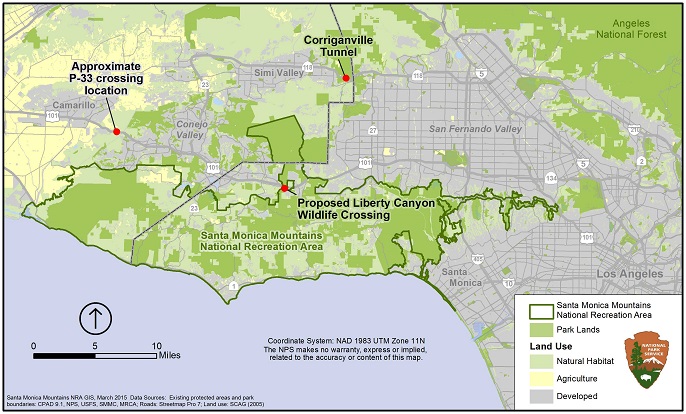|
You are viewing ARCHIVED content published online before January 20, 2025.
Please note that this content is NOT UPDATED, and links may not work. For current information,
visit https://www.nps.gov/aboutus/news/index.htm.

National Park Service
Contact: Kate Kuykendall, 805-370-2343 THOUSAND OAKS, Calif. -- For only the second time since the National Park Service began studying local mountain lions in 2002, researchers have documented a successful crossing of the 101 Freeway.The young female cat, known as P-33, also became the first mountain lion among more than 35 studied to disperse out of the Santa Monica Mountains. The other big cat to accomplish this feat back in 2009, P-12, crossed in the opposite direction, from the north to the south.
"The GPS points show that the lions we're tracking frequently come right up to the edges of the freeway and then turn around," said Dr. Seth Riley, a wildlife ecologist for the Santa Monica Mountains National Recreation Area. "After more than 10 years of seeing the same pattern in our data, it is very cool to see a lion figure out how to cross the freeway and reach other natural areas to the north."
Providing connections between the big cats of the Santa Monica Mountains and the populations to the north, including in the Santa Susana Mountains and beyond, is critical for maintaining the long-term genetic health of the population. Previous National Park Service research has documented genetic differences north and south of the 101 Freeway, as well as multiple cases of first-order interbreeding.
P-33's dispersal was also significant because it occurred in the Camarillo area, on the farthest western end of the mountains. Although the exact path is unclear, she crossed on the Conejo Grande (see map) on the morning of March 9, sometime between midnight and 2:00 a.m.
"It's remarkable that this lion made it across the 101 alive," said Linda Parks, Ventura County Supervisor and chair of the Santa Monica Mountains Conservancy. "We are fortunate to have vast areas of undeveloped open space for these animals to roam, but we need safe crossing locations for them to keep motorists and animals safe from collisions."
The previous successful crossing, as well as one recent attempt that ended in a lion being struck and killed by a vehicle, both occurred near Liberty Canyon in Agoura Hills. The Liberty Canyon area remains the most ideal location for a proposed wildlife crossing across the 101 Freeway because the habitat connection to the north is the strongest. There is also an existing underpass for wildlife north of Liberty Canyon, under Highway 118.
Efforts to construct the Liberty Canyon crossing received a boost earlier in the year when the State Coastal Conservancy awarded Caltrans $1 million to conduct the environmental assessment and develop initial designs.
P-33 is a 16-month-old female that had only recently left her mother and was recently the subject of a series of stunning remote camera photographs. The National Park Service has been tracking P-33 and her two siblings since they were four weeks old.
The Griffith Park mountain lion known as P-22 is believed to have crossed the 101 and 405 Freeways as he headed east, but he was not wearing a tracking device at the time. His dispersal is not considered successful by biologists because he remains hemmed in by multiple freeways on the eastern end of the Santa Monica Mountains and has no opportunities for reproduction.
Since 2002, the National Park Service has been studying mountain lions in and around the Santa Monica Mountains to determine how they survive in an increasingly fragmented and urbanized environment.
Santa Monica Mountains National Recreation Area (SMMNRA) is the largest urban national park in the country, encompassing more than 150,000 acres of mountains and coastline in Ventura and Los Angeles counties. A unit of the National Park Service, it comprises a seamless network of local, state and federal parks interwoven with private lands and communities. As one of only five Mediterranean ecosystems in the world, SMMNRA preserves the rich biological diversity of more than 450 animal species and 26 distinct plant communities. For more information, visit www.nps.gov/samo.
###
|
Last updated: March 18, 2021
